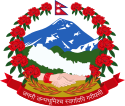Prime Ministers of Nepal
| Prime Minister of Nepal नेपालको प्रधानमन्त्री |
|
|---|---|

|
|
| Residence | Singha Durbar, Kathmandu |
| Appointer |
Bidhya Devi Bhandari as President of Nepal |
| Inaugural holder | Damodar Pande (Mul-Kaji) |
| Formation | 1799 (Mul-Kaji) |
The position of Prime Minister of Nepal (Nepali: नेपालको प्रधानमन्त्री, Nēpālkō Pradhānmantrī) in modern form was called by different names at different times of Nepalese history. At the time of the Shah dynasty, the Mul-Kajis served the function of Prime Ministers. In 1806, the position of Mukhtiyar was created by Rana Bahadur Shah, and the title was subsequently adopted. "Mukhtiyar" is formed from two words: 'Mukhya' and 'Akhtiyar'. Mukhya means Chief and Akhtiyar means Authority. Altogether it means the "Executive Head of the State". During the Rana dynasty, the position of Prime Minister was hereditary and the officeholder held additional titles — Maharaja of Lambjang and Kaski, Supreme Commander-in-Chief of Nepal and Grand Master of the Royal Orders of Nepal.
Mukhtiyar Bhimsen Thapa was the first person to be referred to as Prime Minister by the British. However, the first Mukhtiyar to title himself as Prime Minister, as per the British convention, was Bhimsen's nephew, Mathabar Singh Thapa.
Few of Nepalese Prime Ministers have carried a democratic mandate. The first elected Prime Minister was Bishweshwar Prasad Koirala, in 1959. After he was deposed and imprisoned in 1960, the King established the Panchayat system and Nepal did not have a democratic government until 1990, when the country became a constitutional monarchy after the Jana Andolan movement. The monarchy was abolished on 28 May 2008 by the 1st Constituent Assembly.
The current Prime Minister is Sher Bahadur Deuba, since 7 June 2017.
...
Wikipedia

